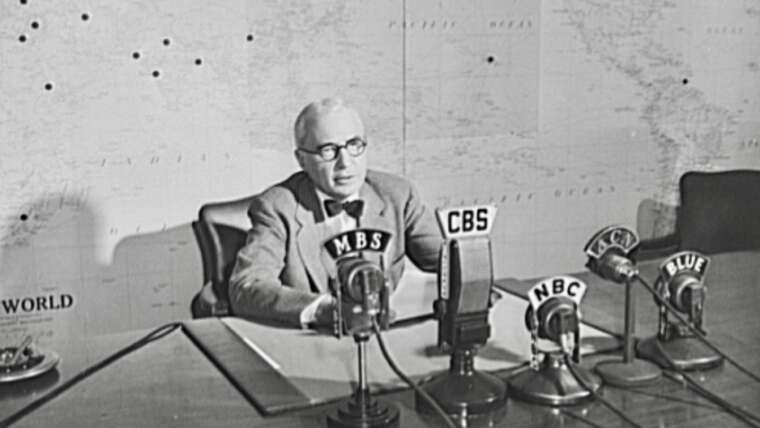Cold War Radio Museum Books in Paperback and Kindle Cold War Radio Museum The “Divide and Conquer” pamphlet published by the U.S. Office of War Information (O.W.I.) in 1942 is a unique example of government attempts to warn Americans during World War II about the dangers of Nazi propaganda and to help them identify and guard against enemy disinformation. The…
Cold War Radio Museum New York, New York. 1943 “United Nations” exhibition of photographs presented by the United States Office of War Information (OWI) on Rockefeller Plaza. Listening to broadcasts of President Roosevelt, Churchill, Stalin, and Chiang Kai-shek, heard every half-hour from a loudspeaker at one end of the frame containing the Atlantic Charter. This frame is surrounded by four…

Cold War Radio Museum Elmer Davis, Director, Office of War Information (OWI), Alfred T. Palmer, photographer. Part of: Farm Security Administration – Office of War Information Photograph Collection, Library of Congress Prints and Photographs Division, Washington, D.C. 20540. Soviet Russia’s lie that Hitler and Nazi Germans and not Stalin and Soviets communists were responsible for the mass execution murder of…
First VOA Director was a pro-Soviet communist sympathizer, State Dept. warned FDR White House
Cold War Radio Museum April 1943 – State Department Warns White House of Soviet Influence at Voice of America May 4, 2018 Analysis by Ted Lipien for Cold War Radio Museum In 2018, the online Cold War Radio Museum presented for the first time to a broader online audience a secret 1943 memorandum sent to the Roosevelt White House by the U.S.…
April 20, 1943 — Congressman Woodruff warns of Soviet propaganda in Voice of America broadcasts
Cold War Radio Museum On April 13, 1943, Nazi Germany’s propaganda machine announced the discovery of the graves containing the bodies of thousands of Polish prisoners of war in Soviet captivity who went missing in Russia in the spring of 1940. A few days later, on April 16 and April 17, 1943, the management of the U.S. Office of War…
Cold War Radio Museum Declassified documents in the National Archives show that a directive issued to on April 17, 1943 by the management of the U.S. Office of War Information (OWI) ordered its Overseas Branch in charge of what were later called Voice of America (VOA) radio broadcasts to air and promote the Soviet propaganda denial of Soviet responsibility for…
Cold War Radio Museum Fascinating and until now generally unknown details of how a single refugee journalist, Julius Epstein, exposed Voice of America’s (VOA) censorship designed to cover up Soviet responsibility for the 1940 Katyn Forest massacre of nearly 22,000 Polish POW officers and intellectual leaders can be found in several volumes of the Congressional Record from the early 1950s…
Cold War Radio Museum Ted Lipien Polish socialist and communist activist and journalist Stefan Arski, aka Artur Salman, was among several communist agents of influence who had worked on Voice of America (VOA) radio programs during World War II while employed by the U.S. government Office of War Information (OWI). Arski and several of his Voice of America colleagues on…
OPINION Cold War Radio Museum How Voice of America Censored Solzhenitsyn Brief History of VOA’s Domestic Propaganda By Ted Lipien The Voice of America (VOA) was an easier target than Radio Free Europe (RFE) or Radio Liberty (RL) for U.S. government bureaucrats wanting to restrict human rights broadcasting to the Soviet Union in 1974 as part of the…
Cold War Radio Museum During the Reagan Administration, foreign language services at the Voice of America (VOA) were for the first time given in the 1980s significant freedom to originate their own news reports and to share them with VOA English programs. Some of these news reports and news backgrounders with audio actualities were also shared in English through the…
Cold War Radio Museum Could a foreign power such as Russia try to infiltrate the Voice of America (VOA) or influence its executives, broadcasters and programs? Could U.S. government-hired journalists and program contributors, acting on their own, support in VOA broadcasts accommodation with authoritarian rulers in countries such as China, Cuba, Iran or even North Korea? Could one-sided propaganda produced…
Executive Order 9182 Establishing the Office of War Information June 13, 1942 In recognition of the right of the American people and of all other peoples opposing the Axis aggressors to be truthfully informed about the common war effort, and by virtue of the authority vested in me by the Constitution, by the First War Powers Act, 1941, and as…
Cold War Radio Museum Commentary by Ted Lipien In his February 26, 1962 speech to mark the 20th anniversary of the Voice of America (VOA), President Kennedy discussed the necessity of freedom of information and complete truthfulness of the press, but he also argued that the Voice of America is different from private U.S. news media. He pointed…
Cold War Radio Museum In 1951, the Voice of America (VOA), which was at that time located primarily in New York but managed from Washington by the State Department, was under heavily criticism, particularly from Republicans in the U.S. Congress, for failing to counter Soviet propaganda. There was a spirited debate as to whether VOA should continue to offer primarily…
SOLZHENITSYN Target of KGB Propaganda and Censorship by Voice of America
OPINION Cold War Radio Museum How Voice of America Censored Solzhenitsyn SOLZHENITSYN, Target of KGB Propaganda and Censorship by Voice of America By Ted Lipien This research article, written for Cold War Radio Museum website to coincide with the 100th anniversary of the 1917 Bolshevik coup in Russia, deals primarily with censorship at the U.S. taxpayer-funded and government-run Voice of…